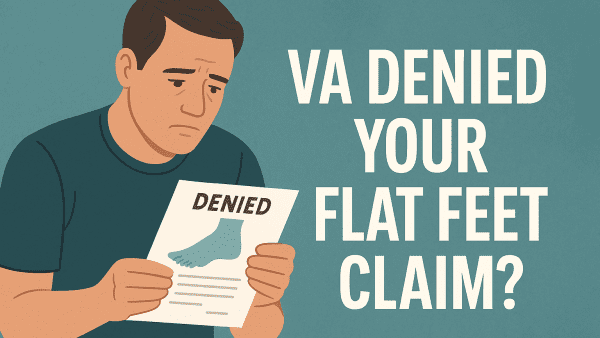Looking for Expert-Level VA Claim Answers?📱Call Us Now! 737-295-2226
If your Supplemental Claim just came back denied or underrated, don’t tap out.
You still have options, and choosing the right next move can change everything.
In this expert guide, Brian Reese explains when you can file a Higher-Level Review (HLR) after a denied Supplemental Claim, when you should do it, how the lanes differ, and how to execute with confidence so you can get the VA disability benefits you’ve earned.
Short answer: Yes, you can request a Higher-Level Review of an initial VA claim or a Supplemental Claim decision if you file within one year of the decision letter and the claim isn’t contested.
No new evidence is allowed in an HLR, but a senior reviewer will take a fresh look at the record and can fix legal or factual errors quickly.
To help you decide your best path, we’ll cover the HLR and Supplemental lanes, timelines, practical examples, and a 10-question FAQ.
We’ll also link out to key resources on VA.gov, the Code of Federal Regulations (38 CFR Part 4), and the VA’s M21-1 Adjudication Procedures Manual, plus in-depth tutorials on the VACI Blog.
Let’s begin!
Table of Contents
Summary of Key Points
- Yes, you can HLR a denied Supplemental Claim (within 1 year). If your Supplemental Claim is denied or underrated, you may request a Higher-Level Review (HLR) of that decision within one year of the decision letter—so long as the claim isn’t contested. HLR is a de novo review by a senior reviewer; no new evidence is accepted. Use VA Form 20-0996 and focus on legal/factual error already in the record.
- Pick the right lane: error = HLR; new evidence = Supplemental. HLR is best when VA misapplied the law/M21-1, overlooked favorable evidence (e.g., prior DBQ, nexus letter), or relied on a flawed C&P exam—without adding new evidence. A Supplemental Claim is the right move when you have new and relevant evidence (private records, updated diagnostics, nexus letters, DBQs, lay statements). You can file additional Supplemental Claims whenever you have fresh, relevant evidence.
- Know the limits and timelines before you file. You generally can’t file a second HLR on the same issue; if you still disagree after an HLR, add new evidence via Supplemental or consider a Board Appeal. For timing, VA aims for ~125 days per lane; in practice, HLRs often run ~4–6 months, while well-documented, single-issue Supplemental Claims can finish in ~60–90 days (complex cases with exams often take ~4–5 months).
- Execute with precision to speed things up. For HLR, a tight written brief that pinpoints the error, cites 38 CFR Part 4 and relevant M21-1 sections, and references exact evidence already in the file can be faster than requesting an informal conference (which can add time). For Supplemental, submit targeted, high-quality evidence and respond promptly to exams/records requests to stay on the fast track.
HLR vs. Supplemental Claim: What’s the Difference?
Under the VA’s Appeals Modernization Act (AMA), you have three lanes after a VA claim denial or an underrated decision: (1) Higher-Level Review (HLR), (2) Supplemental Claim, or (3) Board Appeal.
This article focuses on HLR and Supplemental—the two fastest routes most veterans use:
- #1. Higher-Level Review (HLR): A more senior VA reviewer conducts a de novo (brand-new) review of the same evidence already in your file. No new evidence is allowed. You can request a one-time informal conference to explain the error in the prior decision. Learn more on VA.gov: Higher-Level Reviews.
- #2. Supplemental Claim: You add new and relevant evidence not previously considered (e.g., private medical records, Nexus Letters, DBQs, lay statements). Start here on VA.gov: Supplemental Claims.
Want a deeper dive on strategy?
Read: Higher-Level Review vs. Supplemental Claim and The VA Supplemental Claim Timeline & Steps our Blog.
Can I File an HLR of a Denied Supplemental Claim?
Yes. If you disagree with your Supplemental Claim decision, you can file an HLR within one year from the date on your decision letter using VA Form 20-0996.
This option is ideal when the VA made a mistake in how it evaluated the evidence that was already in the record.
Important limitations:
- You generally cannot do an HLR after an HLR on the same issue. If an HLR already happened and you still disagree, consider a new Supplemental Claim (with new and relevant evidence) or a Board Appeal.
- HLR is not available for contested claims. Learn more about contested claims rules and timelines here: Contested Claims.
When an HLR Makes Sense (After a Supplemental Denial)
You’ll usually choose HLR when:
- VA misapplied the law or ignored M21-1 guidance; or
- VA overlooked favorable evidence already in the file (e.g., a private DBQ, specialist opinion, or a strong Nexus Letter you previously submitted); or
- A bad C&P exam drove the denial, and the existing record undermines that exam’s probative value; and
- You’re not submitting new evidence—this is about correcting errors.
Pro Tips: anchor your argument to the law and evidence. If you’re challenging rating percentages or functional loss, cite the Schedule for Rating Disabilities (38 CFR Part 4). If you’re pointing to internal procedures, cite the applicable M21-1 section (for example, see M21-1, Part X, Subpart ii, Chapter 2 for Supplemental considerations).
When a New Supplemental Claim Is the Better Play
Choose a new Supplemental Claim if you’ve now obtained new and relevant evidence the VA hasn’t considered yet.
You can file as many new Supplemental Claims as you’d like assuming you have new and relevant evidence each time.
Examples include:
- Private medical records or specialty opinions (e.g., neurology, psychiatry, cardiology)
- Nexus Letter connecting your condition to service
- DBQ detailing severity and functional impact
- Lay evidence (your statement, spouse/family statements, buddy letters) describing onset, frequency, severity, and daily impact
Need help deciding which lane is best?
Read this next: Higher-Level Review vs. Supplemental Claim.
Real-World Examples
- Example #1 (HLR Wins): A Navy veteran filed a Supplemental Claim for migraines with a private DBQ and treatment records already in the file. VA denied, stating there was “no confirmed diagnosis.” He filed an HLR, highlighted the DBQ’s diagnosis and frequency documentation, and requested an informal conference. The senior reviewer corrected the error and granted 50%.
- Example #2 (Supplemental Wins): An Army veteran was denied for PTSD due to lack of a corroborated stressor. After denial, she began therapy with a private psychologist who documented the DSM-5 diagnosis and nexus; she also secured a buddy statement. She filed a new Supplemental Claim with the new and relevant evidence and was granted service connection.
How to File an HLR (After a Supplemental Denial)
- Check your decision date. You have one year to file HLR. Protect your effective date.
- Complete VA Form 20-0996. File online here: Request Higher-Level Review. Be precise about the error(s) and the issues under review.
- Consider the one-time informal conference. It’s your chance to point the reviewer directly to the law and evidence—but it can extend processing time. If speed matters, a tight written argument can be just as effective.
- Remember: no new evidence. If you need to add evidence, use the Supplemental lane instead: File a Supplemental Claim.
For appeal option success benchmarks, review VA Disability Appeal Success Rates.
Strategy Flowchart
#1. Did the VA clearly misapply the law or overlook favorable evidence already in the file?
- Yes → Consider filing an HLR (VA Form 20-0996).
- No → Go to #2.
#2. Do you have new and relevant evidence that wasn’t previously submitted?
- Yes → File a Supplemental Claim (VA Form 20-0995).
- No → Consider HLR anyway (argue error) or explore a Board Appeal if appropriate.
Key Considerations Before You File
- Timeliness: File within one year of the decision letter to protect your effective date and retro.
- Evidence vs. Error: If you need more (or better) medical proof, go Supplemental. If the rater got it wrong with the evidence already in the record, go HLR.
- Documentation Quality: Tight, targeted evidence wins faster: specialist notes, diagnostics, nexus letters, DBQs, and lay statements that specifically address the VA’s reasons for denial.
- Backbone for Your Arguments: When arguing percentages or functional loss, cite 38 CFR Part 4. When citing internal procedures, reference the M21-1.
Frequently Asked Questions (FAQs)
Can I file an HLR of a denied Supplemental Claim?
Yes. If you disagree with your Supplemental Claim decision, you may request an HLR within one year. Choose HLR when you’re alleging legal or factual error with the evidence already of record.
When is an HLR the right choice?
Pick HLR if the VA misapplied the law, ignored favorable evidence, or relied on a flawed C&P exam—and you’re not adding new evidence. You’re asking a senior reviewer to fix the prior decision based on the existing record.
When should I file another Supplemental Claim instead?
Go Supplemental when you’ve obtained new and relevant evidence that VA didn’t consider before—such as private specialist opinions, Nexus Letters, DBQs, updated diagnostics, or targeted lay evidence.
What exactly is “new and relevant” evidence?
It’s evidence not previously in the file that tends to prove or disprove a matter at issue (e.g., diagnosis, nexus, severity, functional impact).
Can I submit new evidence with an HLR?
No. HLR is a fresh review of the existing record only. If you need to add new evidence, switch to the Supplemental lane.
How long does an HLR take?
The VA’s stated goal is ~125 days, but real-world HLRs commonly run 4–6 month depending on workload, number of issues, and whether the prior decision had legal/factual complexities. Requesting a one-time informal conference can be helpful, but it usually adds time. If speed matters, skip the call and submit a tight written brief that pinpoints the error, cites the law (38 CFR/M21-1), and references the exact evidence already in the file. Single-issue HLRs with clear error tend to finish faster.
How long does a Supplemental Claim take?
The VA’s target is 125 days. In practice, a well-documented, single-issue Supplemental Claim often finishes in ~60–90 days. If the VA orders new C&P exams, needs to chase records, or you’ve got multiple complex issues, expect ~4–5 months (sometimes longer). Submitting tight, relevant evidence and attending exams promptly can keep you on the faster end.
Can I do multiple HLRs on the same issue?
Generally, no. Once an HLR is completed for an issue, you can’t request another HLR on that same issue. If you still disagree, add new and relevant evidence via a Supplemental Claim or consider a Board Appeal.
What if my claim is contested?
HLR isn’t available for contested claims (where another party’s entitlement is directly affected). Review the rules and Board timelines here: Contested Claims.
Which forms do I need and where do I file?
For HLR, use VA Form 20-0996 (file online or by mail). For Supplemental, use VA Form 20-0995. Start from the VA’s decision review hub: Request a Decision Review.
Conclusion & Wrap-Up
A VA claim denial is not the end of the road—it’s a detour.
If your Supplemental Claim gets denied and the VA misapplied the law or overlooked favorable evidence already in the record, file an HLR and make your legal/evidentiary case.
If what you really need is stronger medical proof, file a new Supplemental Claim with new and relevant evidence not previously considered.
File within one year to protect your effective date and retro, argue with precision, and stay on offense.
About the Author

Brian Reese
Brian Reese is a world-renowned VA disability benefits expert and the #1 bestselling author of VA Claim Secrets and You Deserve It. Motivated by his own frustration with the VA claim process, Brian founded VA Claims Insider to help disabled veterans secure their VA disability compensation faster, regardless of their past struggles with the VA. Since 2013, he has positively impacted the lives of over 10 million military, veterans, and their families.
A former active-duty Air Force officer, Brian has extensive experience leading diverse teams in challenging international environments, including a combat tour in Afghanistan in 2011 supporting Operation ENDURING FREEDOM.
Brian is a Distinguished Graduate of Management from the United States Air Force Academy and earned his MBA from Oklahoma State University’s Spears School of Business, where he was a National Honor Scholar, ranking in the top 1% of his class.



